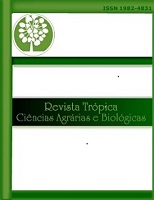ANATOMY OF JAMBEIRO PLANTS FORMED THROUGH CUTTINGS IN A HYDROPONIC SYSTEM
Palabras clave:
Jambo, Vegetative Propagation, Hydropony, Syzygium malaccensisResumen
The jambeiro is a fruit tree widely valued in South and Central America, but commercial production of seedlings through seeds is limited because the seeds are recalcitrant and produced irregularly in the fruits. For this reason, propagation by cuttings becomes a viable alternative to obtain uniform and early seedlings. This work aimed to produce jambeiro seedlings through cuttings in a hydroponic system. Semi-woody and herbaceous cuttings were used, with the base of the cuttings immersed in a solution containing 2 g L-1 of Indole-Butyric Acid and immediately transferred to a tray containing a nutrient solution. After 60 days, leaves and roots
were collected for anatomical analysis. In the leaves, transverse sections of the leaf blade and abaxial and adaxial paradermis were obtained, and in the roots, transverse sections were obtained. It was found that the hydroponic system proved to be viable for the formation of jambeiro seedlings. Anatomical analyzes demonstrated adequate development of the shoot tissues and root system of the seedlings, suggesting that they have the potential to survive after planting in the field. This represents a significant contribution to the sustainable production of jambeiro seedlings, especially in reforestation and environmental conservation contexts.
Descargas
Citas
ARUMUGAM, B. MANAHARAM, T; HENG, C.K.; KUPPUSAMY, U.R.; PALANISAMIA, U.D. Antioxidant and antiglycemic potentials of a standardized extract of Syzygium malaccense. LWT - Food Science and Technology, v. 59, n. 2, Part 1, p. 707–712, 1 dez. 2014.
CARVALHO, P.E.R. Espécies arbóreas brasileiras. Colombo: Embrapa-CNPF; Brasília, DF: Embrapa Informação Tecnológica, 2003. 1039 p.
DIAS, P. C.; OLIVEIRA, L.S.; XAVIER, A.; WENDLING, I. Estaquia e miniestaquia de espécies florestais lenhosas do Brasil. 2012.
FALCÃO, M. DE A.; PARALUPPI, N. D.; CLEMENT, C. R. Fenologia e produtividade do Jambo (Syzygium malaccensis) na Amazônia Central. Acta Amazonica, v. 32, p. 3–8, mar. 2002.
INOUE, M. T.; PUTTON, V. Macropropagação de 12 espécies arbóreas da floresta ombrófila mista. Revista Floresta, v. 37, n. 1, p. 55-61, 2007.
NEVES, T.S.; CARPANEZZI, A.A.; ZUFFELLATO-RIBAS, K.C.; MARENCO, R.A. Enraizamento de corticeira-da-serra em função do tipo de estaca e variações sazonais. Pesquisa agropecuária brasileira, v. 41, p. 1699-1705, 2006.
PRIMACK, R.B. & RODRIGUES, E. Biologia da conservação. Editor Efraim Rodrigues, 2001.
SANTOS, J. L.; MATSUMOTO, S. N.; D’ ARÊDE, L. O.; LUZ, I. S.; VIANA, A. E. S. Propagação vegetativa de estacas de Passiflora cincinnata Mast. em diferentes recipientes e substratos comerciais. Revista Brasileira de Fruticultura, v.34, n.2, p. 581-588, 2012.
SAVVAS, D.; GRUDA, N. Application of soilless culture technologies in the modern greenhouse industry – A review. EUR. J. Hortic. Sci., v. 83, n. 5, pág. 280-293, 2018.
Descargas
Publicado
Cómo citar
Número
Sección
Licencia

Esta obra está bajo una licencia internacional Creative Commons Atribución-NoComercial-SinDerivadas 4.0.
Direitos autorais Revista Trópica: Ciências Agrárias e Biológicas
Este obra está licenciado com uma Licença Creative Commons Atribuição-NãoComercial-SemDerivações 4.0 Internacional.








